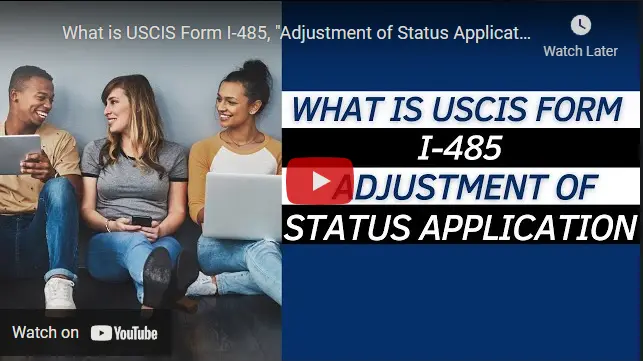Many people like you want to immigrate to the US. But, it can take years before you become a lawful permanent resident. That’s why many dreamers move to the United States in other ways. One of these is through adjustment of the status, using a form called I-485. In this article, we will discuss what adjustment of status means, who is eligible, the requirements, and the process. It is always best to seek legal professional advice from a reliable immigration law firm like Andres Mejer Law so that important information is thoroughly understood and no questions are left unanswered.
What is Adjustment of Status?
Adjustment of Status is the immigration process in the United States where you can shift from one immigration status, such as a temporary visa holder, like a tourist, to permanent resident status, more popularly known as a green cardholder.
In the 1950s, before you could get a green card, you had to leave the US, go back to your home country, apply for an immigrant visa, and then come back to the US again. This is called “consular processing,” It still exists today for visa applicants outside the US. If you are already in the US, you might not have to leave. Adjustment of Status may be the answer you’re looking for!
Who is eligible for Adjustment of Status?
If you’re in the US on a non-immigrant visa and want to get a green card through adjustment of status, you must fall into one of these categories:
Category 1: Family-based petition.
You qualify for a family-based green card if you’re the spouse, child, parent, or sibling (or another close relative, such as stepchild) of a U.S. citizen;
Category 2: Employment-based petition.
You qualify for an employment-based green card. Your employer is sponsoring you because you have special skills, talent, or abilities that enable you to be eligible for one, or you’re a qualified investor.
Category 3: Special circumstances
If you are a refugee or asylee, special immigrant juvenile, U-visa, VAWA, or included in a diversity lottery, you fall into another special category.
How does the Adjustment of Status work?
First, whoever is sponsoring your petition, your family member or your employer, must file an immigration petition for you to get an immigrant visa, like form I-130 for a family petition or form I-140 for an employment-based petition. You have to wait for the petition’s approval and for a visa to become available to file Form I-485. In some cases, you can file the visa petition concurrently with form I-485 depending on the category. One example would be entering the United States legally, and your US Citizen spouse is filing for your green card. Please take note of some specific qualifications:
- If your eligibility is through a family-based or employment-based petition, you must:
- already have an approved visa petition on file and
- Your priority date must be current unless you have a concurrent petition simultaneously as the adjustment of status application.
- If your eligibility is based on asylum or refugee status, you are qualified if:
- it has been a year since your asylum approval or
- it has been a year since your entry into the United States with refugee status.
Next, you must be physically present in the US when filing your Form I-485
You generally should remain in the U.S. while the case is pending. In some cases, you must have entered the U.S. legally, and you must still be in a valid visa status when you adjust your status. That means you did not overstay your visa or violate the terms of the visa, like by working illegally. There shouldn’t be any significant change in your circumstances, like the death of the US Citizen petitioning for you.
What are the documents you need to prepare?
Applying for adjustment of status entails compiling numerous documents aside from filling out the application form I-485, formally known as Application to Register Permanent Residence or Adjust Status.
- A copy of a government-issued identity document with a photograph such as a passport or a driver’s license.
- A copy of your birth certificate (translated word-for-word, if it’s not in English).
- If you do not have a birth certificate, you will need other evidence of birth, such as a church, school, or medical records and proof of unavailability or nonexistence of the birth certificate.
- If you are filing concurrently, you will be submitting the following forms. If you’ve already received approvals of these, you can just submit copies of the approval notice.
- One is Form I-130 and supporting documents if your green card is family-based
- Another is Form I-140 if your green card is employment-based, or
- Some other petitions as appropriate such as the I-360 for special immigrants, like for VAWA, widowers, or Special Immigrant Juvenile petitions.
- Form I-94 Arrival/Departure Record for those who entered the U.S. legally and are adjusting status on that basis.
- Two passport-style photographs.
- Form I-693 (Report of Medical Examination and Vaccination Record) – results of medical examination done by a doctor accredited by the USCIS. This form establishes that you are not inadmissible to the United States on public health grounds.
- Even if you don’t need to submit I-693, like a fiance visa, you still need to comply with vaccination requirements.
- Form I-765, Application for Employment Authorization – application for employment authorization, allowing you to work in the United States.
- Copy of Marriage certificate for marriage-based applications.
- I-864, Affidavit of Support- for family-based petitions to show that you won’t be inadmissible as a likely “public charge.”
- Letter from your employer and pay stub copies – from employment-based immigrants to prove that the job is still available and that salary will be paid.
What’s next after you have compiled all needed documents?
The following steps are crucial in successfully completing your adjustment of status application:
- Pay the filing fee and biometrics fee.
- Submit the completed packet of forms, documents, photos, and fees to the USCIS office having jurisdiction over your U.S. place of residence. You can check the USCIS website for the address.
- Wait for feedback from USCIS. If you meet the basic requirements, USCIS will process your case. They can then send you a Request for Evidence, a Notice of Intent to Deny or they can process your case.
- Attend your biometrics appointment at the local USCIS office.
- Attend your interview.
Important things to note:
During the interview, the USCIS officer will review your application and ask you questions to determine your eligibility, answer truthfully but don’t admit to any wrongdoing.
It is highly recommended to you review everything that was ever filed with immigration on your behalf BEFORE attending an interview. You never know what they might ask you.
It usually takes between 8 and 14 months to adjust status based on a family relationship. While waiting, you can remain in the United States to stay with your family during the whole process.
Why is it important to seek legal advice from an immigration attorney?
There are many ways to fulfill your dream of being a lawful permanent resident in the US. The process may seem overwhelming or complicated, but a competent immigration attorney in New Jersey can help you get that chance to live permanently and legally in the United States. There are ways to address any issues you may have.
You can call our immigration law firm today if you want to discuss your case or need help on your green card or immigration journey, and our immigration lawyers at Andres Mejer Law will let you know if and how we can help.




